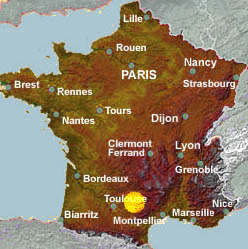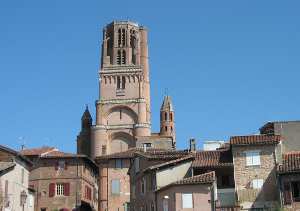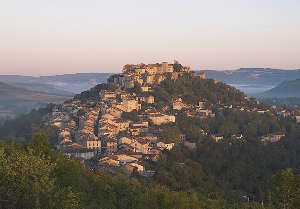A short guide to the Tarn
| Useful links: | Gites in the Tarn | Independent hotels in SW France | Midi Pyrenees regional guide |
 The Tarn - the heart of Southwest France
The Tarn - the heart of Southwest FranceOf all the departments in the Midi-Pyrenées region of southwest France, it is the department of the Tarn that perhaps offers the finest choice of natural and historic tourist resources.
Albi, the capital city of the Tarn, was declared a UNESCO world heritage site back in 2010, and for those who know the city, that came as no surprise.
The red brick used in the historic buildings of Albi and other cities of the Garonne and Tarn basins is a hallmark of the region, and no more so than in Albi, which boasts one of the few mediaeval fortified cathedrals, and the only one to have been built of bricks. The cathedral and the neignbouring bishop's residences were built with massive thick walls,
 as
impressive and defensive affirmations of the power of the Catholic
church in the Middle Ages, in an area which was witness to perhaps the
earliest of Protestant style defiances to its authority, the Albigeois
heresy. The area surrounding the cathedral and the Bishop's palace was
declared a world heritage site, as the world's most
massive concentration of historic brick edifices. Yet inside
the cathedral, the imposing mass of the brick defences is completely
forgotten inside the tracery of a classic Gothic cathedral interior.
as
impressive and defensive affirmations of the power of the Catholic
church in the Middle Ages, in an area which was witness to perhaps the
earliest of Protestant style defiances to its authority, the Albigeois
heresy. The area surrounding the cathedral and the Bishop's palace was
declared a world heritage site, as the world's most
massive concentration of historic brick edifices. Yet inside
the cathedral, the imposing mass of the brick defences is completely
forgotten inside the tracery of a classic Gothic cathedral interior.Beside its cathedral, Albi also boasts one France's great regional art galleries, the Toulouse-Lautrec museum, showing a fabulous display of the city's most famous artist son, the painter of the Parisian Belle-Epoque at the end of the 19th century, Henri de Toulouse-Lautrec.
There is also an old city centre, with some narrow winding streets, and an old bridge over the river Tarn.
Albi is located at the point where the Tarn emerges from the hills, and enters the alluvial plain of the Garonne basin. Twenty-five kilometres downstream, another old brick town, Gaillac, is the heart of a well known area of vineyards, that produce an appellation contrôlée wine. Gaillac wines come in red and white, and they are well known in France as offering good value for money; not coming from one of the high-value internationally renowned wine areas of France, Gaillac wines cannot usually command high prices, however good they may be.
 Though it does not have high mountain areas - these are not far off,
the Pyrenees being easily reachable for a day trip form the Tarn - the
Tarn offers attractive hill country, culminating at the Montgrand in
the east of the department, near Lacaune,
at an altitude of 1267
metres. This eastern part of the department, on the borders of the
Aveyron and the Hérault, is part of the Haut Languedoc regional park,
and offers plenty of opportunites for camping, hiking and cycling. The
east of the Tarn, with its rolling hills, forests and farmland, is
beautiful countryside, fairly remote in parts, and fairly well off the
beaten track.
Though it does not have high mountain areas - these are not far off,
the Pyrenees being easily reachable for a day trip form the Tarn - the
Tarn offers attractive hill country, culminating at the Montgrand in
the east of the department, near Lacaune,
at an altitude of 1267
metres. This eastern part of the department, on the borders of the
Aveyron and the Hérault, is part of the Haut Languedoc regional park,
and offers plenty of opportunites for camping, hiking and cycling. The
east of the Tarn, with its rolling hills, forests and farmland, is
beautiful countryside, fairly remote in parts, and fairly well off the
beaten track.The chief town in the east of the department is Castres - a name that is well known in France and beyond on account of its reputation as a rugby-playing town. Castres has an attractive town centre, with fine renaissance town houses; but is perhaps most famous for its Goya museum. This contains arguably the finest collection of Spanish painting in France outside Paris, including works by Goya, Velasquez, Zurburan, Murillo, Picasso and a great collection of nineteenth-century Spanish masters. The museum is housed in part of the old bishop's palace.
 The fourth town in the Tarn department that lies definitely
on the tourist trail is Cordes-sur-Ciel;
postcards show the town
sitting on its hiltop bursting out of the clouds in the valley below,
literally Cordes on (or perhaps in) the Sky. Cordes is a
picture-postcard stone-built hill town, one of the finest in the
southwest of France; it has a fine collection of medieval and
Renaissance town houses, and is popular with artists.
The fourth town in the Tarn department that lies definitely
on the tourist trail is Cordes-sur-Ciel;
postcards show the town
sitting on its hiltop bursting out of the clouds in the valley below,
literally Cordes on (or perhaps in) the Sky. Cordes is a
picture-postcard stone-built hill town, one of the finest in the
southwest of France; it has a fine collection of medieval and
Renaissance town houses, and is popular with artists.Neighbouring departments offer plenty of opportunity for interesting sightseeing.Toulouse, regional capital of the Midi-Pyrenees area, is a major city with an impressive old city centre and one of the finest piazzas in France, the Place du Capitole. Carcassonne is less than an hour's drive from most places in the department, and to the north the city of Rodez, with its old centre, is worth a visit. The area is also dotted with "bastide" towns, delightful small mediaeval towns built as safe havens during or before the time of the Hundred Years' War.
The Tarn is a relaxing rural part of France, and the best way to visit this area is to stay in gites in or around the Tarn, or discover some of the region's attractive small hotels.